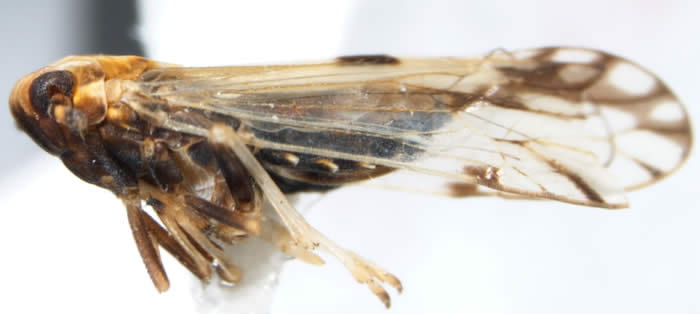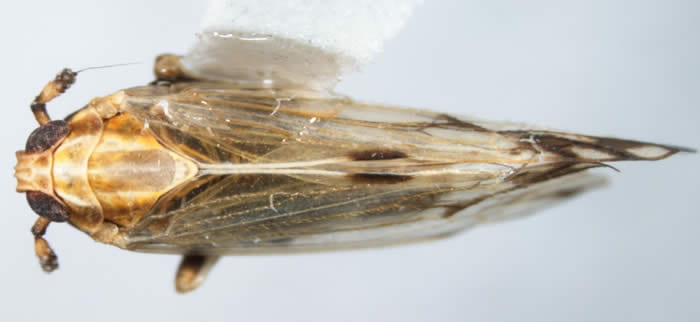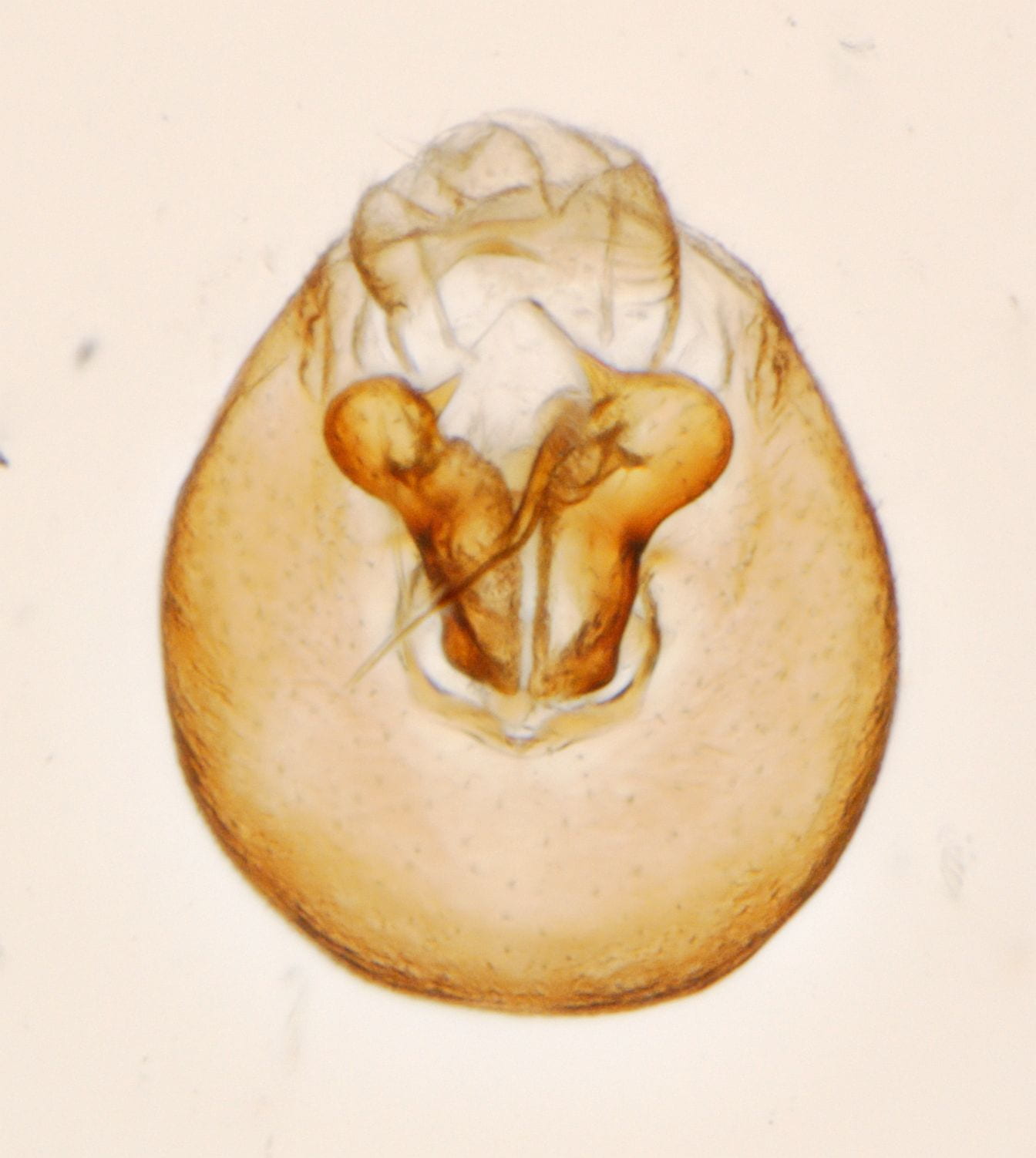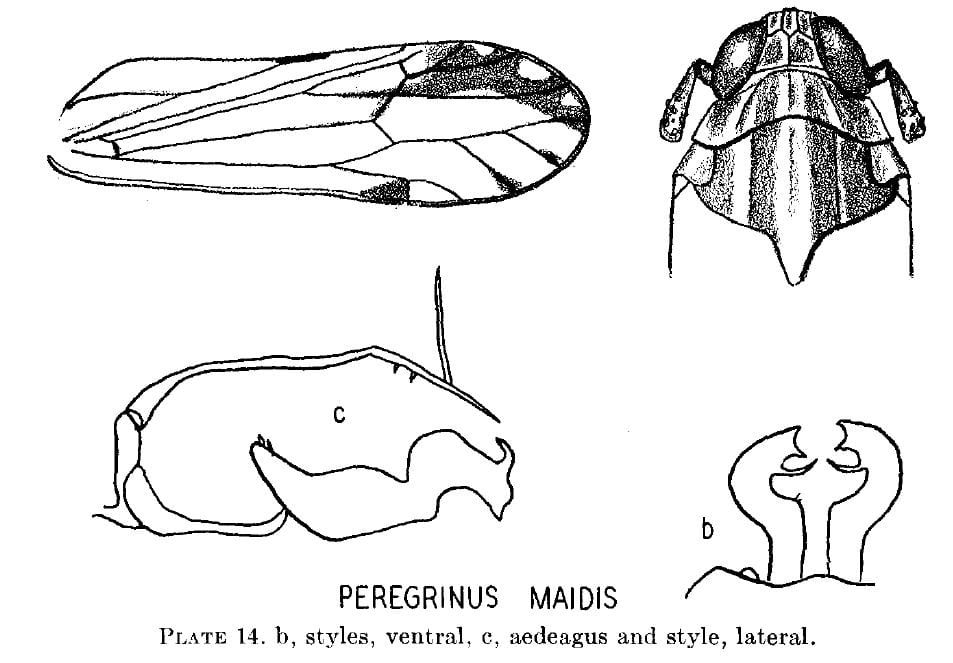[Back to Higher classification of Delphacidae]
Contents
Family Delphacidae Leach, 1815
Subfamily Delphacinae Leach, 1815
Tribe Delphacini Leach, 1815
Genus Peregrinus Kirkaldy, 1904
Type species (in original combination): Delphax maidis Ashmead, 1890
Synonymies
Hagamiella Fennah, 1958 synonym of Peregrinus Kirkaldy, 1904 according to Fennah (1969: 35)
Perigrinus Muir, 1915 wrong spelling of Peregrinus Kirkaldy, 1904
Distribution
Cosmopolitan (found everywhere), although most abundant in tropical and warm temperate regions.

Distribution records of Peregrinus maidis from CABI.
Recognized species
Two recognized species worldwide as follows:
Peregrinus iocasta (Fennah, 1958) – Africa (Uganda, Ghana, etc.)
= Hagamiella iocasta Fennah, 1958, to Peregrinus iocasta (Fennah, 1958) by Fennah (1969: 35).
Peregrinus maidis (Ashmead, 1890) (the corn delphacid) [Metcalf 1943: 251] – Widely distributed (everywhere corn is grown, but most abundant in tropical regions).
= Delphax maidis Ashmead, 1890: 321; original combination
= Dicranotropis maidis (Ashmead, 1890), comb. by Van Duzee (1897: 227, 240), Kirkaldy (1904: 176).
= Delphax psylliodes Lethierry, 1903 (original combination), syn. by Kirkaldy 1907: 132.
= Liburnia psylloides (Lethierry, 1903) comb. by Melichar (1903: 101); synonym by Kirkaldy (1907: 132).
= Pundaluoya simplicia Distant, 1906 synonym by Kirkaldy (1907: 132); also Muir, 1917e: 147).
= Megamelus teapae albinotatus Crawford, 1914, original combination of Delphacodes albinotata (Crawford, 1914) by Muir & Giffard (1924)
= Delphacodes albinotata (Crawford, 1914) [nec Muir & Giffard, 1924] synonym by Beamer (1948: 106).
Distribution of Peregrinus maidis –
USA: AL, AR, CA, DC, DE, FL, GA, HI, IL, LA, NC, NJ, OH, PA, SC, TN, TX, VA; Antigua, Argentina, Bahamas (Exuma Cays, New Providence, N. Bimini) Barbados, Belize, Bermuda, Brazil, British Virgin Islands (Guana); Cayman Is. (Grand Cayman, Cayman Brac), Chile, Columbia, Costa Rica, Cuba, Dominica, Dominican Republic, Grenada, Guadeloupe, Guatemala, Haiti, Honduras, Jamaica, Mexico (Baja California Sur, Chiapas, Chihuahua, Federal District, Guerrero, Nayarit, Sinaloa, Veracruz), Navassa, Nevis, Nicaragua, Panama, Peru, Puerto Rico (inc. Vieques Island), St. Croix, St. Kitts, St. Lucia, St. Thomas, St. Vincent, Surinam, Trinidad, Tobago, Turks & Caicos, Venezuela;
Palearctic: Bonin Islands, Japan, Ryukyus Islands, Okinawa;
Indomalayan: China, Dutch East Indies, India, Indonesia (Java, Ambon, Borneo), Malaysia, Mentawai Islands, Philippine Islands (Luzon), Sri Lanka, Taiwan, Thailand, Viet Nam;
Pacific: Fiji, Galapagos, Guam, Henderson Island, Micronesia (Caroline Islands, Palau, S. Mariana Islands, Yap); New Caledonia and Loyalty Islands; New Hebrides, Pitcairn Isl., Samoa, Society Islands (Tahiti), Tonga;
Australasian: Australia (Queensland, New South Wales, Northern Territory), New Zealand, Soloman Islands;
Afrotropical: Angola, Cape Province, Cape Verde Islands, Cameroons, Canary Islands, Ivory Coast, Ethiopia, Ghana, Gold Coast, Guinea, Kenya, Madagascar, Mauritius (Rodriques Island), Mozambique, Natal, Nigeria, “Rhodesia”, Reunion Island, Senegal, Seychelles, Sierra Leone, South Africa, Sudan, Tanganyika, Yemen, Zambia, Zimbabwe.
Plant associations
Peregrinus maidis is reported from corn (the primary host), Johnsongrass (Sorghum halepense), and Kola.
Peregrinus iocasta has no reported hosts.
Natural enemies and other symbioses
Anagrus flaveolus Waterhouse, 1913 (Hymenoptera, Mymaridae)(Swaminathan & Ananthakrishnan 1984).
Cyrtorhinus lividipennis Reuter, 1885 (Hemiptera, Miridae), an egg predator Verma (1954), Liquido & Nishida (1985).
Anagrus virlai Triapitsyn et al. 2018 (Hymenoptera, Mymaridae) (Hill et al. 2019)
Gonatopus bonaerensis Virla (Espinosa & Virla 2018, Espinosa et al. 2019)
CABI lists the following predators, parasites and pathogens of Peregrinus maidis:
Hymenoptera: Mymaridae – Anagrus breviphragma, Anagrus flaveolus, Anagrus frequens, Anagrus incarnatus, Anagrus optabilis, Anagrus osborni [Hawaii, maize] (Parasites, Eggs),
Hymenoptera: Encyrtidae – Anagyrus flaveolus (Parasite, Eggs)
Hymenoptera: Eulophidae – Aprostocetus sp., Aprostocetus beatus, Aprostocetus indicus, Tetrastichus pallidipes (Parasite, Eggs)
Hymenoptera: Dryinidae – Haplogonatopus apicalis (Parasite, Nymphs)
Hymenoptera: Formicidae – Pheidole megacephala (Predator, Eggs/Nymphs)
Coleoptera: Coccinellidae – Cheilomenes sexmaculata, Coccinella septempunctata, Coelophora inaequalis (Predator, Nymphs)
Dermaptera: Chelisochidae – Chelisoches morio (Predator, Eggs/Nymphs)
Hemiptera: Miridae – Cyrtorhinus lividipennis (Predator, Eggs/Nymphs [Hawaii, maize]), Tytthus mundulus (Predator, Eggs), Tytthus parviceps (Predator),
Hemiptera: Reduviidae – Zelus peregrinus (Predator, Eggs/Nymphs)
Acari, Erythraeidae, Erythraeinae – Bochartia sp. (Parasite, Adults/Nymphs)
Bacillales (Bacteria – Staphylococcus sciuri (Pathogen)
Mutualists (ants) are reported by Dejean et al. (1996, 2000); Peregrinus maidis is evidently facultatively ant tended.
Economic importance
Peregrinus maidis is a vector of Finger millet mosaic virus (FMMV), Iranian maize mosaic virus (IMMV), Maize sterile stunt virus (MSSV), and Maize stripe virus (MSV). It is a very common and mobile species that is frequently found at lights considerable distances from likely host plants. See also here (Leafhopper, Planthopper & Psyllid vectors of plant disease).
Peregrinus iocasta has no apparent economic importance, although specimens may be abundant at lights (the sex ratio of specimens at lights is very strongly female biased, based on museum specimens).
Recognition
Peregrinus maidis is a very distinctive species. It is larger than many delphacids with slightly patterned wings and a pale stripe along the midline of the body; the middle carina of the face is forked well below the top of of the head in frontal view. Also, when viewing the specimen from the front, the face is often straw-colored near the top of the head and darker on lower portions of the face. On host plants, short-winged forms can be very abundant.
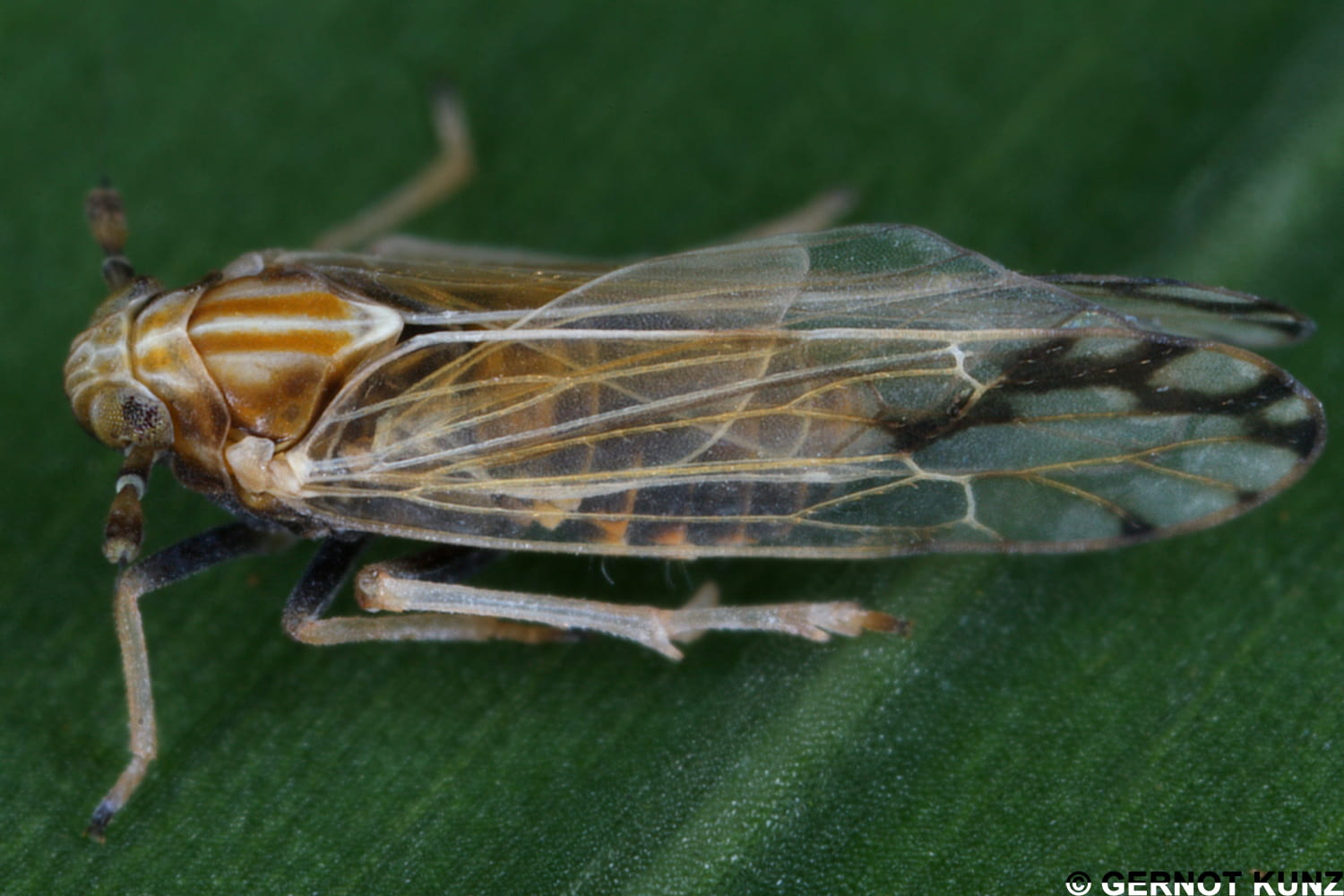
Peregrinus maidis from FLOW by Gernot Kunz (from Costa Rica).
Photos below courtesy Lindsey Flexner, Daniel Vincent; Insect Resistance Management Science, Dupont Agricultural Biotechnology.
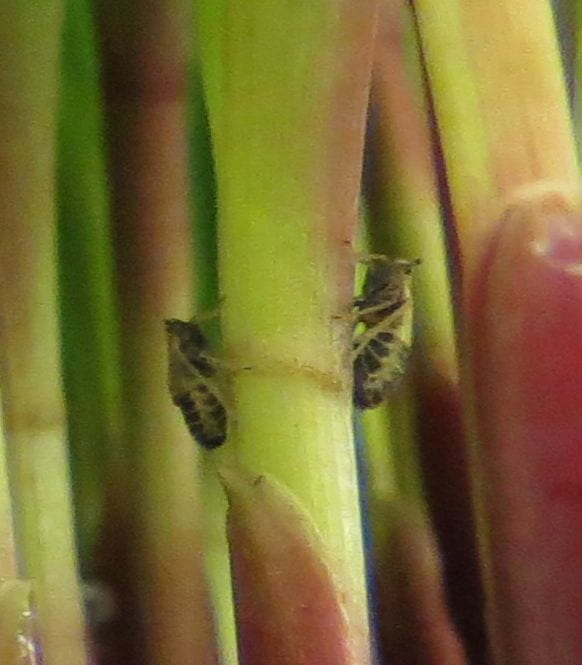
Peregrinus maidis – Photos courtesy Lindsey Flexner, Daniel Vincent; Insect Resistance Management Science, Dupont Agricultural Biotechnology.
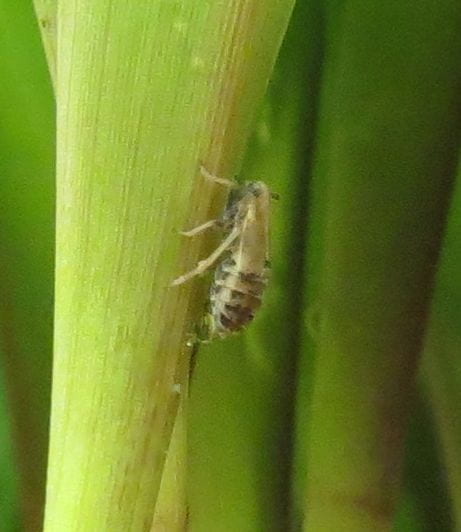
Peregrinus maidis – Photos courtesy Lindsey Flexner, Daniel Vincent; Insect Resistance Management Science, Dupont Agricultural Biotechnology.
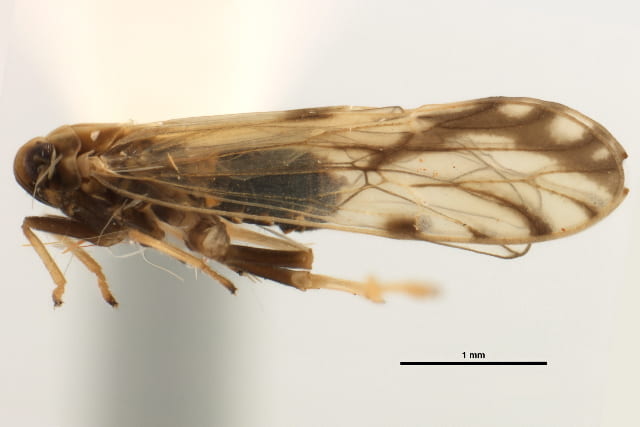
Peregrinus maidis (From BOLD, cnc#hem405680+1345744924)
Online Resources
3I Interactive Keys and Taxonomic Databases.
EOL.
Bugguide.
Discover Life.
FLOW.
Hoppers of North Carolina.
Kunzweb Gallery. (link to family)
American Insects. (link to family)
BOLD.
Wikipedia.
CABI.
Additional photos
https://en.wikipedia.org/wiki/File:Peregrinus_maidis_from_USDA.jpg
http://visualsunlimited.photoshelter.com/image/I0000M_UAYDvD_wA
http://www.nbaii.res.in/Pestsofcrops/Peregrinus-maidis.html
I have no photos of the African Peregrinus iocasta, but it is quite different from P. maidis. Photos will be posted when they are available.
Molecular resources
There are a lot of resources available Peregrinus maidis in Genbank, including a complete mitochondrial genome (16,279 bp). BOLD has barcode data available (7 Mar. 2020).
Select references
(references are intended to include biology, nomenclatural acts, host associations and geographic references; the list is undoubtedly incomplete).
Agarwal, R. K., R. S. Verma and G. S. Bharaj. 1978. Screening of sorghum lines for resistance against shoot bug, Peregrinus maidis Ashmead (Homoptera: Delphacidae). JNKVV (Jawaharlal Nehru Krishi Vishwa Vidyalaya) Research Journal 12: 116.
Ammar, El-Desouky. 1985. Internal morphology and ultrastructure of leafhoppers and planthoppers. Pp. 127-162. In: L. R. Nault and J. G. Rodriguez. The leafhoppers and planthoppers. John Wiley & Sons,New York, USA.
Ammar, El-Desouky. 1986. Ultrastructure of the salivary glands of the planthopper, Peregrinus maidis (Ashmead) (Homoptera: Delphacidae). International Journal of Insect Morphology and Embryology 15(5-6): 417-428.
Ammar, El-Desouky, 1987. Ultrastructural studies on the planthopper, Peregrinus maidis (Ashmead), vector of maize mosaic and maize stripe viruses. Pp. 83-92. In: M. R. Wilson and L. R. Nault.Proceedings of 2nd International Workshop on Leafhoppers and Planthoppers of Economic Importance. Brigham Young University, Provo, Utah, USA, 28th July-1st August 1986. London, UK; CAB International Institute of Entomology.
Ammar, E. D., L. R. Nault, W. E. Styer and Y. M. Saif. 1987. Staphylococcus, paramyxovirus-like, rickettsia-like and other structures in Peregrinus maidis (Homoptera, Delphacidae). Journal of Invertebrate Pathology. 49(2): 209-217.
Ammar, E. D. and S. A. Hogenhout. 2008. A neurotropic route for Maize mosaic virus (Rhabdoviridae) in its planthopper vector Peregrinus maidis. Virus Research 131: 77–85.
Anaji R. and R. A. Balikai. 2007. Management of shoot bug, Peregrinus maidis (Ashmead) through seed dressers. Pp. 232-235. In: S. Ignacimuthi, and S. Jayaraj (eds.). Biotechnology and Insect Pest Management. Elite Publishing House Pvt Ltd, New Delhi, India.
Anaji, R. and R. A. Balikai. 2007. Screening of rabi sorghum genotypes against shoot bug, Peregrinus maidis (Ashmead). International Journal of Agricultural Science 3(2): 144-146.
APPPC, 1987. Insect pests of economic significance affecting major crops of the countries in Asia and the Pacific region. Technical Document No. 135. Bangkok, Thailand: Regional Office for Asia and the Pacific region (RAPA). 56 pp.
Asche, M. 1988b. Delphacidae from Cote d’Ivoire (Homoptera, Fulgoroidea). Revue Francaise d’Entomologie (Nouvelle Serie) 10: 151-231.
Asche, M. 1997. A review of the systematics of Hawaiian planthoppers (Hemiptera: Fulgoroidea). Pacific Science 51: 366-376.
Ashmead, W. H. 1890. The corn delphacid, Delphax maidis. Psyche 5: 321-324.
Attié M., T. Bourgoin, J. Veslot and A. Soulier-Perkins. 2008. Patterns of trophic relationships between planthoppers (Hemiptera: Fulgoromorpha) and their host plants on the Mascarene Islands. Journal of Natural History 42(23-24): 1591-1638.
Ayyar, P. N. K. 1935. The biology and economic status of the common black ant of south India Camponotus (Tanaemyrmex) compressus. Bulletin of Entomological Research. London 26: 575-585.
Barandoc-Alviar, K., G. M. Ramirez, D. Rotenberg and A. E. Whitfield. 2016. Analysis of acquisition and titer of Maize Mosaic Rhabdovirus in its vector, Peregrinus maidis (Hemiptera: Delphacidae). Journal of Insect Science 16(1): 14; 1–8. DOI: 10.1093/jisesa/iev1154.
Barber, G. W. and B. B. Pepper. 1942. The corn lantern fly in New Jersey. (Homoptera: Fulgoridae). Entomological News 53:22.
Barringer, L. E. and C. R. Bartlett. 2018. Pennsylvania planthoppers (Hemiptera: Auchenorrhyncha: Fulgoroidea): relative abundance and incidental catch using novel trapping methods. Insecta Mundi 0661: 1–31
Bartlett, C. R. 2013. National. Pest Alert. The corn delphacid Peregrinus maidis (Ashmead, 1890) (Hemiptera: Fulgoroidea: Delphacidae). National Pest Alert. U.S. Department of Agriculture, National Institute of Food and Agriculture, Regional IPM Centers and the 1862 Land-Grant Universities. pdf
Bartlett, C. R. and G. Kunz. 2015. A new genus and species of delphacid planthopper (Hemiptera: Fulgoroidea: Delphacidae) from Central America with a preliminary regional species list. Zootaxa 3946(4): 510–518.(Erratum.Zootaxa 3963(4): 598-600).
Bartlett, C. R., L. B. O’Brien and S. W. Wilson. 2014. A review of the planthoppers (Hemiptera: Fulgoroidea) of the United States. Memoirs of the American Entomological Society 50: 1-287.
Beamer, R. H. 1948. Some new species of Delphacodes (Homoptera, Fulgoridae, Delphacinae). Part V. Journal of the Kansas Entomological Society 21: 111-119.
Bonfils, J.,S. Quilici and B. Reynaud. 1994. Les Hémiptères Auchénorrhynques de l’Ile de la Réunion. Bulletin de la Société Entomologique de France 99: 227-240.
Brandes, E. W. 1923a. Mechanics of inoculation with sugar-cane mosaic by insect vectors. Journal of Agricultural Research 23: 279-283. [Notes on the methods of feeding of Peregrinus maidis and Draeculacephala mollipes.]
Buduca, C., S. Reynaud, D. Lan-Sun-Luk and F. Molinaro. 1996. Electrical penetration graphs from Peregrinus maidis on a susceptible maize hybrid. Entomologia Experimentalis et Applicata 79(2): 131-139.
Caldwell, J. S. and L. F. Martorell. 1951 [dated 1950]. Review of the Auchenorynchous [sic] Homoptera of Puerto Rico. Part II. The Fulgoroidea except Kinnaridae. Journal of Agriculture of the University of Puerto Rico 34(2): 133-269.
Chelliah, S. and M. Basheer. 1965. Biological studies of Peregrinus maidis (Ashmead) (Araeopidae: Homoptera) on sorghum. Indian Journal of Entomology 27: 466-471.
Coll Araoz, M. V., E. G. Virla, V. G. Jacobi, J. Zavala and P. C. Fernandez. 2017. Behavioral differences in host-finding among two maize disease vectors: Dabulus maidis (Cicadellidae) and Peregrinus maidis (Delphacidae). Pp. 103-104. In: G. Mejdalani and M. Felix (eds). Abstracts Book, 15th International Auchenorrhyncha Congress and 10th International Workshop on Leafhoppers and Planthoppers of Economic Importance. July 9th -15th 2017. Mendes, Brazil.
Coll Aráoz, M.V., V.G. Jacobi, P.C. Fernandez, E. Luft Albarracin, E.G. Virla, J.G. Hill and C.A.N. Catalán. 2019. Volatiles mediate host-selection in the corn hoppers Dalbulus maidis (Hemiptera: Cicadellidae) and Peregrinus maidis (Hemiptera: Delphacidae). Bulletin of Entomological Research (ePub ahead of print): 10 pp. https://doi.org/10.1017/S000748531900004X
Crawford, D. L. 1914a. A contribution toward a monograph of the homopterous insects of the family Delphacidae of North and South America. Proceedings of the United States National Museum 46:557-640, plus 6 plates.
Dejean A., P. R. Ngnegueu and T. Bourgoin. 1996. Trophobiosis between ants and Peregrinus maidis (Hemiptera, Fulgoromorpha, Delphacinae). Sociobiology 28(1): 111-120.
Dejean A., J. Orivel, J. L. Durand, P. R. Ngnegueu, T. Bourgoin and M. Gibernau. 2000. Interference between ant species distribution in different habitats and the density of a maize pest. Sociobiology 35(1): 175-189.
Denno, R. F., G. K. Roderick and K. L. Olmstead. 1991. Density-related migration in planthoppers (Homoptera: Delphacidae): the role of habitat persistence. American Naturalist 138: 1513-1541.
Distant, W. L. 1906. The fauna of British India, including Ceylon and Burma. 3: 503 pp. Lt. Col. C. T. Birgham.
Espinosa, M.S. and E.G. Virla. 2018. Egg maturation by Gonatopus bonaerensis (Hymenoptera: Dryinidae) when provided with two species of planthopper (Delphacidae) as hosts. Biological Control 117: 123–127. https://doi.org/10.1016/j.biocontrol.2017.11.001.
Espinosa, M. S., G. A. Van Nieuwenhove and E. G. Virla. 2019. Host makes the difference: The effect of two planthopper host species on host-feeding and parasitism activities of the pincer wasp Gonatopus bonaerensis. BioControl 64(6): 655–664. https://doi.org/10.1007/s10526-019-09962-0
Etienne, J., G. Delvare and H.-P. Aberlenc. 1992. Contribution à lа connaissance de I’arthropodofaune associée аuх cultures de Casamance (Senegal). Bollettino di Zoologia agraria e di Bachicoltura II, 24(2): 159-193.
Falk, B. W., K. S. Kim, and J. H. Tsai. 1988.Electron microscope and physiochemical analysis of a reo-like virus of the planthopper Peregrinus maidis. Intervirology 29:195-206.
Falk, B. W. and J. H. Tsai. 1985. Serological detection and evidence for multiplication of maize mosaic virus in the Planthopper, Peregrinus maidis. Phytopathology 75(7): 852-855.
Fennah, R. G. 1950. Fulgoroidea of Fiji. Bulletin Bernice P. Bishop Museum 202: 1-122.
Fennah, R. G. 1956b. Insects of Micronesia, Homoptera: Fulgoroidea. Bernice P. Bishop Museum Insects of Micronesia 6: 39-211.
Fennah, R. G. 1957. Results from the Danish expedition to the French Cameroons, 1949-1950. XXIV. Fulgoroidea. Bulletin de l’Institut Fondamental d’Afrique Noire, series A 19: 1274-1311.
Fennah, R. G. 1958a. Fulgoroidea from West Africa. Bulletin de l’institute Francaises de Afrique Noire 20. Series A Pp. 20: 460-538.
Fennah, R. G. 1958b. Hemiptera. Homoptera. Fulgoroidea. Pp. 193-211. In: B. Hanstrom, P. Brinck and G. Rudebeck (eds.). South African Animal Life (Results of the Lund University Expedition in 1950-1951), Volume V. Almqvist and Wiksell. Stockholm, Sweden.
Fennah, R. G. 1958c. Fulgoroidea of South-eastern Polynesia. Transactions of the Royal Entomological Society of London 110: 117-220.
Fennah, R. G. 1959. Delphacidae from the Lesser Antilles (Homoptera: Fulgoroidea). Bulletin of the British Museum (Natural History). Entomology 8: 245-365.
Fennah, R. G. 1965c. Delphacidae from Australia and New Zealand (Homoptera: Fulgoroidea). Bulletin of the British Museum (Natural History) Entomology 17(1): 1-59.
Fennah, R. G. 1969. Delphacidae (Homoptera: Fulgoroidea) from the Sudan Republic. Acta Entomologica Fennica., Helsinki 26: 1-78.
Fennah, R. G. 1971a. Fulgoroidea from the Cayman Islands and adjacent areas. Journal of Natural History 5: 299-342.
Fennah, R. G. 1971b. Homoptera: Fulgoroidea, Supplement. Insects of Micronesia, Bernice P. Bishop Museum 6(8): 563-609.
Fennah, R. G. 1975. Homoptera: Delphacidae from Ceylon. Entomologica Scandinavica (Supplement) 4: 79-136
Fennah, R. G. 1978a. Fulgoroidea (Homoptera) from Vietnam. Annales Zoologici 34(9): 207-279.
Fernandez, B. A. 1988. Description e identification de los huevos e instares de la chicharrita del maiz, Peregrinus maidis (Homoptera: Delphacidae). Memoria de la Sociedad De Ciencias Naturales la Salle 48(129): 117-125.
Fernandez, B. A. 1989. El nombre valido de la chicharrita del maiz, Peregrinus maidis (Homoptera: Delphacidae). Boletin de Entomologia Venezolana 5(4): 37-38.
Fernandez, B. A. 1992. Morfologia de los adultos de la chicharrita del maiz, Peregrinus maidis (Homoptera: Delphacidae). Memoria de la Sociedad de Ciencias Naturales la Salle 52(137): 17-35.
Fernandez, B. A. and A. S. Clavijo. 1990. Polimorfismo alar de la chicharrita del maiz, Peregrinus maidis (Homoptera: Delphacidae) en Venezuela. Revista de la Facultad de Agronomia (Maracay) 16(1: 27-33.
Fernandez, B. A. and A. S. Clavijo. 1990. Muestreo de la chicharrita del maiz, Peregrinus maidis (Homoptera: Delphacidae), en Venezuela. Revista de la Facultad de Agronomia (Maracay) 16(3-4): 259-263.
Fernandez, B. A. and A. S. Clavijo. 1990. Biologia de la chicharrita del maiz, Peregrinus maidis (Homoptera: Delphacidae), en Venezuela. Revista de la Facultad de Agronomia (Maracay) 16(1): 35-45.
Fernandez, B. A. and A. S. Clavijo. 1990. Dinamica poblacional de la chicharrita del maiz Peregrinus maidis (Homoptera: Delphacidae) en Venezuela. Agronomia Tropical (Maracay) 39(4-6): 311-317.
Fullaway, D. T. 1918. The corn leafhopper Peregrinus maidis (Ashmead). Bulletin. Board of Commissioners of Agriculture and Forestry, Hawaii, Division of Entomology. 4: 3-16.
Gingery, R. E. 1983. Maize stripe virus. Pp. 69-74. In: D.T. Gordon, J.K. Knoke, L.R. Nault, and R.M. Ritter (eds.). Proceedings: International Maize Virus Disease Colloquium and Workshop, Wooster, Ohio, August 2-6, 1982. Ohio Agricultural Research and Development Center. Wooster, Ohio. pdf
Hayashi, M. and S. Fujinuma. 2016. Part Fulgoromorpha. In: Entomological Society of Japan 2016 – Catalogue of the insects of Japan. Volume 4 Paraneoptera (Psocodea, Thysanoptera, Hemiptera), 4. Editorial Committee of Catalogue of the Insects of Japan. p. 323-355.
Higashi, C.H.V. and A. Bressan. 2011. Influence of Maize mosaic virus on the fitness and wing morphology of Peregrinus maidis (Hemiptera: Delphacidae). Phytopathology 101(6 Supplement): S72.
Higashi, C.H.V. and A. Bressan. 2013. Infection rates and comparative population dynamics of Peregrinus maidis (Hemiptera: Delphacidae) on corn plants with and without symptoms of maize mosaic virus (Rhabdoviridae: Nucleorhabdovirus) infection. Environmental Entomology 42(5): 949-956.
Higashi, C.H.V., J.L. Brewbaker, and A. Bressan. 2013. Influence of the corn resistance gene Mv on the fitness of Peregrinus maidis (Hemiptera: Delphacidae) and on the transmission of Maize mosaic virus (Rhabdoviridae: Nucleorhabdovirus). Journal of Economic Entomology 106(4): 1878-1886.
Hill, J. G., E. L. Albarracin, M. V. Coll Araoz, E. G. Virla. 2019. Effects of host species and host age on biological parameters of Anagrus virlai (Hymenoptera: Mymaridae), an egg parasitoid of Dalbulus maidis (Hemiptera: Cicadellidae) and Peregrinus maidis (Hemiptera: Delphacidae). Biological Control 131: 74-80. https://doi.org/10.1016/j.biocontrol.2018.12.002.
Hu, S.J., D.Y . Fu, X. J. Liu, T. Zhao, Z. L. Han, J. P. Lu, H.L. Wan and H. Ye. 2012. Diversity of planthoppers associated with the winter rice agroecosystems in southern Yunnan, China. Journal of Insect Science 12(29): 29. https://doi.org/10.1673/031.012.2901
Kennedy, A. C., C. R. Bartlett and S. W. Wilson. 2012. An annotated checklist of the delphacid planthoppers (Hemiptera: Delphacidae) of Florida with the description of three new species and the new genus, Meristopsis. Florida Entomologist 95(2): 395-421.
Kirkaldy ,G. W. 1904. Some new Oahuan (Hawaiian) Hemiptera. The Entomologist. An illustrated Journal of Entomology. London 37: 174-179.
Kirkaldy, G. W. 1907. Descriptions et remarques sur quelques Homoptères de la famille des Fulgoroideae vivant sur la canne à sucre. Annales de la Société entomologique de Belgique 51: 123-127.
Kumar, L.V. and A. Prabhuraj. 2007. Field efficacy of certain new chemicals and economics of shoot bug management in rabi sorghum. Journal of Plant Protection and Environment 4(1):1-5.
Leach, W. E. 1815a. Entomology. The Edinburg encyclopedia; conducted by David Brewster 9: 57-172. (family Delphacidae here).
Lethierry, L. F. 1894a. A new species of Fulgoridae. Indian Mus. Notes 3:105-106. Fig(s).: a-k. [Delphax psyllodies n. sp.]
Linnavuori, R. 1973. Hemiptera of the Sudan, with remarks on some species of the adjacent countries 2. Homoptera Auchenorrhyncha: Cicadidae; Cercopidae, Machaerotidae, Membracidae and Fulgoridae (Zoological contribution to the Sudan no. 33). Notulae Entomologicae 53(3): 65-137.
Liquido, N. J. and T. Nishida. 1985. Population parameters of Cyrtorhinus lividipennis Reuter (Heteroptera: Miridae) reared on eggs of natural and factitious prey. Proceedings of the Hawaiian Entomological Society 15: 87-93.
Llano C. A., C. R. Bartlett and G. Guevara. 2016. First record of the subfamily Asiracinae and Copicerus irroratus (Hemiptera: Auchenorrhyncha: Delphacidae) in Colombia. Florida Entomologist 99(1): 120-122.
Manandhar, R. and M. G. Wright. 2016. Within-field spatial distribution patterns of corn planthopper, Peregrinus maidis, and severity of hopperburn and Maize mosaic virus symptoms as influenced by sunn hemp intercropping. Entomologia Experimentalis et Applicata 161(2): 121-130. DOI: 110.1111/eea.12498.
Marin, L. R. and J. Sarmiento. 1983. Biologia y secuencia estacional de Peregrinus maidis (Ashmead) (Homoptera: Araeopidae). Revista Peruana de Entomologia 24(1) : 107-111.
Melichar, L. 1903. Homopteren-Fauna von Ceylon. 1903: 248 pp.
Mendez Barceló, A. 2007. Algunos aspectos bioetologicos de Peregrinus maidis Ashmead (Homoptera: Delphacidae) en la zona norte de la provincia de Las Tunas, Cuba. Fitosanidad 11(2): 69-73.
Metcalf, Z. P. 1923. A key to the Fulgoridae of Eastern North America with descriptions of new species. Journal of the Elisha Mitchell Scientific Society 38: 139-230.
Metcalf, Z. P. 1943. General Catalogue of the Hemiptera. Fascicle IV, Fulgoroidea, Part 3, Araeopidae (Delphacidae). Smith College, Northhampton, Massachusetts. (p. 251).
Miskimen, G. W. and R. M. Bond. 1970. The Insects of St. Croix, United States Virgin Islands. Scientific Survey of Porto Rico and the Virgin Islands, New York Academy of Sciences. 12: 1-114.
Muir, F. A. G. 1915. A contribution towards the taxonomy of the Delphacidae. Canadian Entomologist 47: 208-212.
Muir, F.A.G. 1917e. On the synonymy of Delphax maidis Ashm. Canadian Entomologis. 49:147.
Muir, F. A. G. and W. M. Giffard. 1924a. Studies in North American Delphacidae. Bulletin. Hawaiian Sugar Planters’ Association Experiment Station. Division of Entomology. Honolulu 15: 1-53.
Napompeth, B. 1973. Ecology and population dynamics of the com planthopper, Peregrinus maidis (Ashmead) (Homoptera: Delphacidae), in Hawaii. Ph.D. Dissertation. University of Hawaii, Honolulu, Hawaii. 257 pp.
Nault, L. R. 1983. Orgins of leafhopper vecors of maize pathogens in Mesoamerica. Pp. 75-82. In: D.T. Gordon, J.K. Knoke, L.R. Nault, and R.M. Ritter (eds.). Proceedings: International Maize Virus Disease Colloquium and Workshop, Wooster, Ohio, August 2-6, 1982. Ohio Agricultural Research and Development Center. Wooster, Ohio.
Nault, L. R. 1987. Origin and evolution of Auchenorrhycha-trnsmitted, plant infecting viruses. In: M.R. Wilson and L.R. Nault, (eds.). Proceedings of the Second International Workshop on Planthoppers of Economic Importance. Brigham Young University, Provo, Utah. CAB International Institute of Entomology, London, UK. Pp. 131-149.
Nault, L. R. and D. T. Gordon. 1988. Multiplication of maize stripe virus in Peregrinus maidis. Physopathology 78: 991-995.
Nault, L. R., D. T. Gordon, R. E. Gingery, O. E. Bradfute and J. C. Loayza. 1979. Identification of maize viruses and mollicutes and their potential insect vectors in Peru. Phytopathology, 69(8):824-828
Nishida, T. 1978. Management of the corn planthopper in Hawaii. FAO (Food and Agriculture Organization of the United Nations) Plant Protection Bulletin 26(1): 5-9.
Oromi, P., S. De la Cruz and M. Báez. 2010. Hemiptera. p. 234-253. In: Arechavaleta M., Rodriguez S., Zurita N. & Garcia A. 2010 – Lista de especies silvestres de Canarias. Hongos, plantas y animales terrestres. 2009., Gobierno de Canarias, Tenerife (Spain).
Osborn, H. 1916d. Order Homoptera. In Agricultural entomology for students, farmers, fruit-growers and gardeners. Lea & Febiger . Philadelphia, New York. Vol./pp.: i-iv, 17-347. Fig(s).: 1-252. (see p. 103).
Osborn, H. 1921a. Homoptera of Florida. Florida Entomologist 5(1): 1-19.
Quaintance, A. L. 1898. The corn Delphax (Delphax maidis, Ashmead). Bulletin Florida Agricultural Experiment Station 45: 61-67.
Padrón, W. 2006. Estadío ninfal de Peregrinus maidis Ashm. a temperatura no controlada. Agrícola Centro 33(3): 5-8.
Pemberton, C. E. 1964. Highlights in the history of entomology in Hawaii 1778-1963. Pacific Insects 6(4): 689-729.
Raju, A. and R. A. Balikai. 2012. Management of shoot bug, Peregrinus maidis (Ashmead) through seed treatment in Rabi Sorghum. Annals of Plant Protection Sciences 20(1): 37-41.
Rawat, R. R. and D. K. Saxena. 1967. Studies on the bionomics of Peregrinus maidis (Ashmead) (Homoptera: Araeopidae). JNKVV (Jawaharlal Nehru Krishi Vishwa Vidyalaya) Research Journal 1: 64-67.
Rioja, T. C., H. Vargas and D. Bobadilla. 2010. Observations about differential fertility of two alar morphotypes on Peregrinus maidis (Ashmead) (Hemiptera: Delphacidae) under laboratory conditions. Idesia 28(2): 89-95.
Rioja, T. C., H. E. Vargas and D. E. Bobadilla. 2006. Biologia y enemigos naturales de Pereginus maidis (Ashmead) (Hemiptera: Delphacidae) ien el Valle de Azapa. [Biology and Natural Enemies of Peregrinus maidis (Ashmead) (Hemiptera: Delphacidae) in the Azapa Valley]. Idesia 24(1): 41-48.
Rodriguez-León, R., M. M. Hidalgo-Gatov and N. Novo. 1994a. Fulgoroideos en la cana de azúcar y la vegetación sinantrópica [Fulgoroidea on sugar cane and border plant communities]. Ciencias Biologicas Academia de Ciencias de Cuba 27: 18-23.
Shekar, B., K. Reddy, B. Singh and D. Reddy. 1993. Antixenosis component of resistance to corn planthopper, Peregrinus maidis (Ashmead) in sorghum. Insect Science and Its Application 14(1): 77-84. Https://doi.org/10.1017/S1742758400013424
Shekar, B.M.C., B.U. Singh, K.D. Reddy, and D.D.R. Reddy. 1993. Antibiosis component of resistance in sorghum to corn plant hopper, Peregrinus maidis (Ashmead) (Homoptera: Delphacidae). Insect Science and its Application 14(5): 559-569.
Singh, B. U. and B.S. Rana. 1992. Stability of resistance to corn planthopper, Peregrinus maidis (Ashmead) in sorghum germplasm. Insect Science and Its Application 13(2): 251-263.
Singh, B. U. and N. Seetharama. 2008. Host plant interactions of the corn planthopper, Peregrinus maidis Ashm.(Homoptera: Delphacidae) in maize and sorghum agroecosystems. Arthropod Plant Interactions 2(3): 163-196.
Swaminathan, S. and T. N. Ananthakrishnan. 1984. Population trends of some monophagous and polyphagous fulgoroids in relation to biotic and abiotic factors (Insecta: Homoptera). Proceedings of the Indian Academy of Sciences (Animal Science) 93(1): 1-8.
Thontadarya, T.S. and G. P. Channa-Basavanna. 1968. Mode of egg-laying in Peregrinus maidis (Ashmead) (Araeopidae: Homoptera). Mysore Journal of Agricultural Sciences 2: 337-365.
Toledo, A. V., A.M.M. de Remes Lenicov and C. C. Lastra. 2010. Histopathology caused by the entomopathic fungi, Beauveria bassiana and Metarhizium anisopliae, in the adult plant hopper, Peregrinus maidis, a maize virus vector. Journal of Insect Science 10(35): 1-10.
Toledo, A. V., A.M.M. de Remes Lenicov and C. C. Lopez Lastra. 2007. Pathogenicity of fungal isolates (Ascomycota: Hypocreales) against Peregrinus maidis, Delphacodes kuscheli (Hemiptera: Delphacidae), and Dalbulus maidis (Hemiptera: Cicadellidae), vectors of corn diseases. Mycopathologia 163(4): 225-232.
Triapitsyn, S.V., P.F. Rugman-Jones, P.S. Tretiakov, E.L. Albarracin, G. Moya-Raygoza and R.B. Querino. 2019. Molecular, morphological, and biological differentiation between Anagrus virlai sp. n., an egg parasitoid of the corn leafhopper Dalbulus maidis (Hemiptera: Cicadellidae) in the New World, and Anagrus incarnatus from the Palaearctic Region (Hymenoptera: Mymaridae). Neotropical Entomology 48(1): 87–97. https://doi.org/10.1007/s13744-018-0606-7
Tsai, J. H. 1996. Development and oviposition of Peregrinus maidis (Homoptera: Delphacidae) on various host plants. Florida Entomologist 79(1): 19-26.
Tsai, J. H. and J. L. Perrier. 1993. Morphology of the digestive and reproductive systems of Peregrinus maidis (Homoptera: Delphacidae). Florida Entomologist 76 (3): 428-436.
Tsai, J. H. and S. W. Wilson. 1986. Biology of Peregrinus maidis with descriptions of immature stages. Annals of the Entomological Society of America 79(3): 395-401.
Tsai, J.H. and T. A. Zitter. 1982. Characteristics of maize stripe virus transmission by the corn delphacid. Journal of Economic Entomology 75(3): 397-400
Tsai, J. H., S. W. Wilson and H. C. Faan. 1986. Peregrinus maidis (Homoptera: Delphacidae) from southern China. Journal of the New York Entomological Society 94(3): 442-443.
Tsai, J.H., B. Steinberg and B. W. Falk. 1990. Effectiveness and residual effects of seven insecticides on Dalbulus maidis (Homoptera: Cicadellidae) and Peregrinus maidis (Homoptera: Delphacidae). Journal of Entomological Science 25(1): 106-111.
UK CAB International. 1973. Peregrinus maidis. [Distribution map]. Distribution Maps of Plant Pests, December. Wallingford, UK: CAB International, Map 317.
Varon-de-Agudelo, F. and G. M. Lopez. 1980. Observaciones preliminares sobre la transmission de virus con Peregrinus maidis. Revista Colombiana de Entomologia 6(3-4): 69-76.
Van Dine, D. L. 1911a. The sugar-cane insects of Hawaii. Bull. United States Dept. Agr. Bur. Entomol. (n.s.) 93:1-54. Fig(s).: 1-5. Plate(s): 1-4. (see. p. 34).
Van Duzee, E. P. 1897a. A Preliminary Review of the North American Delphacidae. Bulletin of the Buffalo Society of Natural Sciences 5(5): 225-261. (see p. 240). [http://www.biodiversitylibrary.org]
Van Duzee, E. P. 1917b. Catalogue of the Hemiptera of America North of Mexico (excepting the Aphididae, Coccidae and Aleurodidae). University of California Publications, Technical Bulletins, vol. 2. University of California Press, Berkeley, pp. i-xiv, 1-902. [from Google books] (see p. 769).
Verma, J.S. 1954. A comparative study of the bionomics of Peregrinus maidis (Ashmead) and its egg-predator, Cyrtorhinus mundulus (Breddin) and the toxicity of several contact and systemic insects to the two species. University of Hawaii, Honolulu, Hawaii. Ph.D. Thesis. 159 pp.
Verma, J. S. 1955. Biological studies to explain the failure of Cyrtorhinus mundulus (Breddin) as an egg-predator of Peregrinus maidis (Ashmead) in Hawaii. Proceedings of Hawaii Entomological Society, 60:623-634.
Wang, J. J., J. H. Tsai and T. K. Broshat. 2006. Effect of nitrogen fertilization of corn on the development, survivorship, fecundity and body weight of Peregrinus maidis (Hom., Delphacidae). Journal of Applied Entomology 130(1): 20-25.
Whitfield, A. E., D. Rotenberg, V. Aritua and S. A. Hogenhout. 2011. Analysis of expressed sequence tags from Maize mosaic rhabdovirus-infected gut tissues of Peregrinus maidis reveals the presence of key components of insect innate immunity. Insect Molecular Biology 20(2): 225-242.
Williams, J. R. 1957. The sugarcane Delphacidae and their natural enemies in Mauritius. Transactions of the Royal Entomological Society of London 109: 65-110.
Wilson, M. R. 2009. Fiji Arthropods XII. A checklist of Fiji Auchenorrhyncha (Hemiptera). Bishop Museum Occasional Papers 102: 33-48.
Wilson, M. R. and D. J. Hilburn. 1991. Annotated list of the auchenorrhynchous Homoptera (Insecta) of Bermuda. Annals of the Entomological Society of America 84: 412‑419.
Wilson, S. W. and J. E. McPherson. 1980a. Keys to the planthoppers, or Fulgoroidea, of Illinois (Homoptera). Transactions of the Illinois Academy of Science 73(2): 1‑61.
Wilson, S. W. and J. E. McPherson. 1980b. The distribution of the Fulgoroidea of the eastern United States (Homoptera). Transactions of the Illinois Academy of Science 73(4): 7‑20.
Wilson, S. W. and J. E. McPherson. 1980c. A list of the Fulgoroidea (Homoptera) of southern Illinois. Great Lakes Entomologist 13(1): 25-30.
Wilson, S. W. and J. H. Tsai. 1984. Descriptions of the immature stages and biology of Peregrinus maidis (Ashmead) (Homoptera: Delphacidae). Mitteilungen Schweizerischen Entomologischen Gesellschaft 57: 450-451.
Wolcott, G. N. 1950. The insects of Puerto Rico. [dated 1948]. Journal of Agriculture of the University of Puerto Rico 32(1): 1-224.
Woodruff, R., B. M. Beck, P. E. Skelley, C.Y.L. Schotman and M. C. Thomas. 1998. Checklist and bibliography of the insects of Grenada and the Grenadines. Center for Systematic Entomology, Memoir 2: 1-286.
Yao, J.X., D. Rotenberg, A. Afsharifar, K. Barandoc-Alviar and A. E. Whitfield. 2013. Development of RNAi methods for Peregrinus maidis, the corn planthopper. PLoS ONE 8(8): 1-11.



